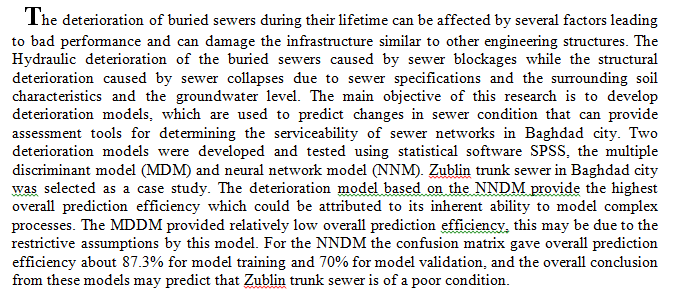
Prenatal markers are commonly used in practice to screen for some foetal abnormalities. They can be biochemical or ultrasonic markers in addition to the newly used cell free Deoxyribonucleic Acid (DNA) estimation. This review aimed to illustrate the applications of the prenatal screening, and the reliability of these tests in detecting the presence of abnormal chromosomes such as trisomy-21, trisomy-18, and trisomy-13 in addition to neural tube defects. Prenatal markers can also be used in the anticipation of some obstetrical complications depending on levels of these markers in the mother’s circulation. In the developed countries, prenatal screening tests are regularly used during antenatal care period. Neural tube defects, numer
... Show MoreThis paper proposed a new method to study functional non-parametric regression data analysis with conditional expectation in the case that the covariates are functional and the Principal Component Analysis was utilized to de-correlate the multivariate response variables. It utilized the formula of the Nadaraya Watson estimator (K-Nearest Neighbour (KNN)) for prediction with different types of the semi-metrics, (which are based on Second Derivative and Functional Principal Component Analysis (FPCA)) for measureing the closeness between curves. Root Mean Square Errors is used for the implementation of this model which is then compared to the independent response method. R program is used for analysing data. Then, when the cov
... Show More (2)
(2)
 (1)
(1)
Over the past few decades, the surveying fieldworks were usually carried out based on classical positioning methods for establishing horizontal and vertical geodetic networks. However, these conventional positioning techniques have many drawbacks such as time-consuming, too costly, and require massive effort. Thus, the Global Navigation Satellite System (GNSS) has been invented to fulfill the quickness, increase the accuracy, and overcome all the difficulties inherent in almost every surveying fieldwork. This research assesses the accuracy of local geodetic networks using different Global Navigation Satellite System (GNSS) techniques, such as Static, Precise Point Positioning, Post Processing Kinematic, Session method, a
... Show MoreThis project sought to fabricate a flexible gas sensor based on a short functionalized multi-walled carbon nanotubes (f-MWCNTs) network for nitrogen dioxide gas detection. The network was prepared by filtration from the suspension (FFS) method and modified by coating with a layer of polypyrrole conductive polymer (PPy) prepared by the oxidative chemical polymerization to improve the properties of the network. The structural, optical, and morphological properties of the f-MWCNTs and f-MWCNTs/PPy network were studied using X-ray diffraction (XRD), Fourie-transform infrared (FTIR), with an AFM (atomic force microscopy). XRD proved that the structure of f-MWCNTs is unaffected by the synthesis procedure. The FTIR spectra verified the existence o
... Show More (1)
(1)
 (1)
(1)
This study employs evolutionary optimization and Artificial Intelligence algorithms to determine an individual’s age using a single-faced image as the basis for the identification process. Additionally, we used the WIKI dataset, widely considered the most comprehensive collection of facial images to date, including descriptions of age and gender attributes. However, estimating age from facial images is a recent topic of study, even though much research has been undertaken on establishing chronological age from facial photographs. Retrained artificial neural networks are used for classification after applying reprocessing and optimization techniques to achieve this goal. It is possible that the difficulty of determining age could be reduce
... Show MoreObjective: To generate a model that conceptualizes the phenomenon of health promotion and its related factors.
Methodology: A grounded theory methodology is used as qualitative method to explore the health promotion as
phenomenon of interest and its other related factors from the perspectives of specialists in this field. The study is
carried out from January 2002 through September 2004. A sample of (20) specialists in health sciences are
selected and interviewed as experts in the area of health promotion. The investigators conducted intensive and
structured interviews with the specialists to collect the data. These interviews were transcribed verbatim,
analyzed and interpreted.
Results: Findings of the study indicat
Interval methods for verified integration of initial value problems (IVPs) for ODEs have been used for more than 40 years. For many classes of IVPs, these methods have the ability to compute guaranteed error bounds for the flow of an ODE, where traditional methods provide only approximations to a solution. Overestimation, however, is a potential drawback of verified methods. For some problems, the computed error bounds become overly pessimistic, or integration even breaks down. The dependency problem and the wrapping effect are particular sources of overestimations in interval computations. Berz (see [1]) and his co-workers have developed Taylor model methods, which extend interval arithmetic with symbolic computations. The latter is an ef
... Show MoreStabilization of phenol trapped by agricultural waste: a study of the influence of ambient temperature on the adsorbed phenol
 (24)
(24)
Abstract
The current research aims to construct a scale for the nine types of students’ personality according to Rob Fitzel model. To do this, (162) items were formed that present the nine types of personality with (18) items for each type. To test the validity of the scale, a sample of (584) students of Al-Mustansrya University were chosen. The data of their responses was analyzed by using factor analysis. The findings explored (9) factors as one factor for each type of personality with (12) items for each one. Then, the reliability of the scale was found by using the test-retest method and Alfa Cronbach method.
The nuclear level density parameter in non Equi-Spacing Model (NON-ESM), Equi-Spacing Model (ESM) and the Backshifted Energy Dependent Fermi Gas model (BSEDFG) was determined for 106 nuclei; the results are tabulated and compared with the experimental works. It was found that there are no recognizable differences between our results and the experimental -values. The calculated level density parameters have been used in computing the state density as a function of the excitation energies for 58Fe and 246Cm nuclei. The results are in a good agreement with the experimental results from earlier published work.
